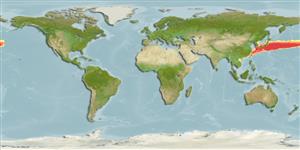Classification / Names
Noms communs | Synonymes | Catalog of Fishes(Genre, Espèce) | ITIS | CoL | WoRMS | Cloffa
>
Stomiiformes (Lightfishes and dragonfishes) >
Stomiidae (Barbeled dragonfishes) > Melanostomiinae
Etymology: Eustomias: Greek, eu = good + Greek, stoma = mouth (Ref. 45335).
Environment: milieu / climate zone / depth range / distribution range
Écologie
marin bathypélagique; profondeur 0 - 932 m (Ref. 34246). Deep-water
Northwest Pacific: southeast of Japan.
Taille / Poids / Âge
Maturity: Lm ? range ? - ? cm
Max length : 12.1 cm SL mâle / non sexé; (Ref. 34246); 12.1 cm SL (female)
Description synthétique
Clés d'identification | Morphologie | Morphométrie
The single-based branch of the barbel arises from the stem; the branch with many elaborate, branched side filaments throughout most of its length with the proximal filaments arising just distal to the main branch origin. Most of the barbel stem unpigmented between branch and terminal bulb (Ref. 34246).
Life cycle and mating behavior
Maturities | Reproduction | Spawnings | Egg(s) | Fecundities | Larves
Clarke, T.A., 1999. Pelagic fishes of the genus Eustomias (Melanostomiidae) similar to Eustomias dendriticus Regan and Trewavas with the description of seven new species. Copeia 1999(4):1002-1013. (Ref. 34246)
Statut dans la liste rouge de l'IUCN (Ref. 130435)
Menace pour l'homme
Harmless
Utilisations par l'homme
Outils
Articles particuliers
Télécharger en XML
Sources Internet
Estimates based on models
Preferred temperature (Ref.
123201): 0.9 - 18.7, mean 11.5 °C (based on 63 cells).
Phylogenetic diversity index (Ref.
82804): PD
50 = 0.5000 [Uniqueness, from 0.5 = low to 2.0 = high].
Bayesian length-weight: a=0.00302 (0.00117 - 0.00783), b=3.12 (2.89 - 3.35), in cm total length, based on LWR estimates for this (Sub)family-body shape (Ref.
93245).
Niveau trophique (Ref.
69278): 4.1 ±0.7 se; based on size and trophs of closest relatives
Résilience (Ref.
120179): Milieu, temps minimum de doublement de population : 1,4 à 4,4 années (Assuming tmax>3).
Fishing Vulnerability (Ref.
59153): Low vulnerability (10 of 100).
